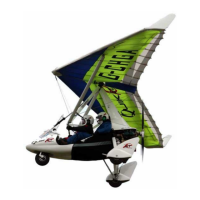
Do you have a question about the P&M Aviation QUIK-GTR and is the answer not in the manual?
| Brand | P&M Aviation |
|---|---|
| Model | QUIK-GTR |
| Category | Toy |
| Language | English |
Provides the address, telephone number, and email for P&M Aviation.
Highlights the importance of registration and safety information.
Explains the meaning of WARNING and CAUTION symbols used in the manual.
Explains the meaning of NOTE symbols indicating helpful information.
Discusses general risks in microlight flying and component material sourcing.
Lists the conditions under which the Quik-GTR aircraft must be flown.
Highlights aircraft design, capabilities, and manual overview.
Details necessary pilot training and licensing for operation.
Covers pilot qualifications, licensing, and type conversion procedures.
Details air law, weather assessment, and route planning.
Covers payload limits, weight restrictions, and modification cautions.
Emphasizes safety harness use and correct ground movement.
Requirements for landing sites and awareness of propeller dangers.
Precautions for exhaust, radiator, and oil systems.
Detailed steps for safely running the engine on the ground.
General layout, capabilities, and introduction to diagrams.
Details wing components, construction, and folding configurations.
Describes sail fabric, aerofoil section, and airframe materials.
Compares Rotax engine specs and describes the trike frame.
Details fuel tank capacity and gauge calibration procedures.
Operation of throttle, choke, ignition switches, and starter.
Brake types, fluid requirements, and parking brake operation.
Describes fuel feed, filters, tank capacity, and fuel type.
Proper use of safety harnesses, fairings, and the windscreen.
Description of the aircraft's electrical wiring and power setup.
Managing engine temperature and preventing carburettor icing.
Function and operation of the electric pitch trim system.
Using the trimmer and the STARS stability system.
Details empty weight and fuel capacity limitations.
Covers CG, aircraft measurements, and engine details.
Flight performance figures and locations of placards.
Graphs of fuel usage and detailed stall characteristics.
Electrical components, wiring, and battery status indicator.
Core operating rules and restrictions for safe flight.
Specific operational limits for the engine.
How to calibrate the airspeed indicator (ASI).
Importance of correct rigging and component checks during assembly.
Key areas requiring inspection during rigging.
Detailed list of checks for rigging components.
Initial steps for rigging the aircraft wing.
Continuing steps for rigging the aircraft wing.
Continuing steps for rigging the aircraft wing.
Continuing steps for rigging the aircraft wing.
Continuing steps for rigging the aircraft wing, including tool usage.
Continuing steps for rigging the aircraft wing.
Continuing steps for rigging the aircraft wing.
Continuing steps for rigging the aircraft wing.
Detailed process for connecting the wing to the trike.
Final connection steps and safety checks.
Comprehensive checks for wing and trike components.
Rules for baggage stowage and briefing passengers on safety.
Harness adjustment, ballast, and initial pre-start checks.
Detailed steps for starting the engine.
Procedures and time required for engine warm-up.
Controls, pitch handling, trimmer, and stall awareness.
Advice on flying in various weather conditions.
Weather limits by experience and basic tuning principles.
Linking control bar inputs to aircraft reactions.
Methods for securing, moving, and braking the aircraft.
Performance factors and critical pre-takeoff checks.
Specifics for solo flight and climb rate.
Managing flight during cruise and control inputs.
Using trim and recovering from stalls.
Pre-landing checks, flare, and touchdown techniques.
Techniques for landing the aircraft in crosswind conditions.
Actions for engine failure and forced landing procedures.
Handling takeoff engine failure and system issues.
Steps to take if a fire occurs on the ground or in the air.
Essential inspection items to perform after flying.
Safe procedures and steps for folding configuration 1.
Steps for achieving a compact folding configuration.
Steps for de-rigging and folding for transport.
Methods for storing a rigged wing and overnight parking.
Initial setup guidelines and basic tuning principles.
Methods for tuning the wing and correcting turns.
Fine-tuning roll response and pitch adjustments.
Adjusting hang point and trim settings for optimal flight.
Care for aluminium tubing, fasteners, cables, and inspection areas.
Maintaining sailcloth, repairing seams, and cleaning the sail.
Caring for wing ribs and adjusting washout rods.
Trike cleaning, storage, and propeller checks.
Instructions on how to set propeller pitch.
Details lubrication points and intervals for the trike.
Maintenance schedules for trike and engine components.
Maintenance schedules for fuel, propeller, gearbox, and frame.
Maintenance schedules for undercarriage and electric trim system.
Maintenance schedule for wing components.
Standards for inspecting general parts, sail, bolts, and cables.
Criteria for inspecting airframe tubes and the hang bracket.
How pitch and roll axes are controlled by the systems.
Procedures for inspecting and adjusting the STARS and trim systems.
Lists components requiring fatigue inspection and their intervals.
Guidelines for repairing the aircraft's wing and trike.
List of modifications required for GTR standard configuration.
List of optional modifications available for the aircraft.
Wiring diagrams for the dashboard and electric start system.
Wiring diagrams for the signal loom and electric trim system.
How the roll trimmer works, its setup, and checks.
Procedures for check flights and maintenance of the roll trimmer.